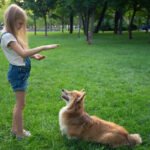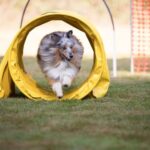Are you looking for a fun and practical way to bond with your dog? Look no further than training your furry friend to find golf balls. In this article, we will explore the numerous benefits of having a golf ball-finding dog, as well as provide you with the essential tips and techniques to successfully train your canine companion.
Training your dog to find golf balls comes with a multitude of advantages. Not only will it save you time out on the course, but it can also reduce the risk of injury from bending over or straining to search for lost balls.
Additionally, this unique skill can strengthen the bond between you and your dog, providing both mental and physical stimulation for your pet. Throughout this article, we will guide you through the process of training your dog to become a valuable asset during your golf games.
Before delving into the training process, it’s crucial to choose the right dog for the job. Characteristics such as a strong sense of smell, high energy levels, and a willingness to train are all ideal traits in a golf ball-finding dog.
Once you have selected an appropriate canine candidate, we will provide you with the necessary steps to introduce basic scent detection training and progress towards more advanced techniques. By honing these skills, your dog will soon be an invaluable partner on the golf course.
Choosing the Right Dog for the Job
When it comes to training your dog to find golf balls, choosing the right breed is crucial. The ideal golf ball-finding dog should possess a strong sense of smell, high energy levels, and be willing to undergo training. Sporting breeds such as Labrador Retrievers, Golden Retrievers, and German Shepherds are popular choices due to their natural hunting instincts and eagerness to learn.
In addition to breed characteristics, it’s important to consider the individual personality of the dog. Look for traits such as curiosity, persistence, and a strong play drive. These attributes can greatly contribute to the effectiveness of your dog’s training and their enjoyment of the task.
Another key consideration is the dog’s physical abilities. Dogs should not only have energy but also stamina, as retrieving golf balls can be physically demanding. It’s important to ensure that your chosen breed or individual dog has the physical capability to perform this activity safely and comfortably.
Lastly, willingness to train is critical. Not all dogs enjoy training exercises or have the patience for repetitive tasks. Ensure that your selected dog has a positive response to training and shows enthusiasm in learning new skills.
| Characteristics | Examples |
|---|---|
| Strong Sense of Smell | Labrador Retriever, Golden Retriever |
| High Energy Levels | German Shepherd, Border Collie |
| Willingness to Train | Australian Shepherd, Springer Spaniel |
Basic Training for Scent Detection
Training your dog to find golf balls can be a fun and rewarding experience for both you and your furry friend. Basic training for scent detection is the foundation for this specialized skill, and it is essential to start with the fundamentals to ensure success. Here are some key steps to consider when embarking on this training journey:
- Introducing the target scent: Begin by introducing your dog to the scent of golf balls in a controlled environment. Allow them to sniff the golf balls while associating the scent with a positive reward, such as treats or praise.
- Recognition and alerting: Once your dog is familiar with the golf ball scent, begin teaching them to recognize it actively. Encourage them to use their sense of smell to locate the golf balls and then provide an alert behavior, such as sitting or pawing at the location.
- Consistent practice: Repetition is key when it comes to training your dog for scent detection. Regular practice sessions will reinforce their ability to find golf balls and strengthen their skills over time.
By laying a solid foundation in basic scent detection training, you can set your dog up for success in finding golf balls and enjoy all the benefits that come with this unique skill. Remember that patience, consistency, and positive reinforcement are vital elements in this process, so be sure to approach each training session with enthusiasm and encouragement for your canine companion.
Introducing Golf Balls as the Target Scent
Once your dog has mastered the basic scent detection training, it’s time to introduce golf balls as the specific target scent. This step is crucial in teaching your furry friend to differentiate between different scents and focus on finding golf balls. Here’s how you can go about introducing golf balls as the target scent:
1. Familiarization: Start by allowing your dog to become familiar with the scent of golf balls. Let them sniff and interact with clean and unused golf balls in a controlled environment to associate the scent with a positive experience.
2. Positive Reinforcement: Use treats or rewards to reinforce the association between the scent of golf balls and something enjoyable. Whenever your dog shows interest in or alerts to the scent of a golf ball, provide praise and a reward to encourage this behavior.
3. Training Games: Incorporate training games into the process, such as hiding golf balls in different locations and encouraging your dog to find them using their sense of smell. This will help strengthen their ability to search for and detect the specific scent of golf balls.
By following these steps, you can effectively introduce golf balls as the target scent in your dog’s training regimen. With patience, consistency, and positive reinforcement, you can help your canine companion become skilled at finding golf balls on the course, making for an enjoyable and productive experience for both of you.
Advanced Training Techniques
Once your dog has mastered the basics of scent detection and has become familiar with the target scent of golf balls, it’s time to delve into more advanced training techniques to further enhance their abilities. One of the key skills to focus on is search patterns, which can help your dog cover a larger area more efficiently.
Introducing different search patterns such as grid searching, spiral searching, or expanding squares can challenge your dog’s ability to locate golf balls in various terrains and conditions.
Another important aspect of advanced training is distance control, which involves teaching your dog to work at a distance from you while still following commands accurately. By gradually increasing the distance between you and your dog during training exercises, you can improve their independence and strengthen their ability to find golf balls without constant supervision. This skill is particularly useful when navigating large areas during a game of golf.
Incorporating advanced obedience commands into your training regimen can also greatly benefit your dog’s ability to find golf balls. Commands such as “stay,” “go,” and “find it” will allow you to effectively direct your dog during searches, making the process more efficient and controlled.
Amidst all the rigorous training, remember that patience and positive reinforcement are key elements in ensuring that your dog continues to enjoy the learning process. With dedication and perseverance, these advanced techniques will improve your dog’s skills and make them an invaluable asset on the golf course.
| Key Skills | Benefits |
|---|---|
| Search Patterns | Enhances ability to locate golf balls in various terrains |
| Distance Control | Improves independence and accuracy during searches |
| Advanced Obedience Commands | Makes search process more efficient and controlled |
Safety Considerations for Golf Ball Retrieval
When training your dog to find golf balls, it is important to consider the safety aspects of this activity. While it can be a fun and beneficial task for your furry friend, there are potential hazards that you need to be aware of.
One of the main concerns is the risk of your dog ingesting or choking on golf balls. To prevent this, always make sure to use non-toxic, durable balls that are too large for your dog to swallow.
Another safety consideration is the physical strain that retrieving golf balls can put on your dog’s body. The repetitive motion of bending down and picking up objects can lead to muscle fatigue or even injury, especially if your dog is not used to this type of activity. It is essential to monitor their behavior and provide sufficient rest breaks during training sessions to avoid overexertion.
Moreover, when working on a golf course, there may be environmental hazards such as pesticides, fertilizers, or other chemicals used in maintaining the grounds. These substances can be harmful if ingested or absorbed through the skin by your dog.
Be sure to supervise them closely and keep them away from any areas that have been treated with potentially toxic substances. By being mindful of these safety considerations and taking proper precautions, you can ensure that training your dog to find golf balls is a safe and enjoyable experience for both you and your canine companion.
Using Your Dog’s Skills to Improve Your Golf Game
Training Drills
Once your dog has mastered the art of finding golf balls, you can incorporate their skills into training drills that can help improve your golf game. Set up practice scenarios where you intentionally “lose” a few golf balls around the course and have your furry companion locate them for you. This not only sharpens your dog’s abilities but also provides you with an opportunity to work on your game without spending unnecessary time searching for lost balls.
Course Navigation
Your trained dog can serve as an invaluable assistant in navigating the golf course. With their heightened sense of smell and keen perception, they can help guide you through areas where errant shots may have landed, making the process of locating and retrieving stray golf balls a breeze.
Retrieval Practice
Utilize your dog’s skill set during actual play by incorporating retrieval practice into your games. If a ball is hit off-course or lands in a difficult-to-reach area, allow your dog to assist in retrieving it. Not only does this save time and effort, but it also adds an element of fun and teamwork to your golfing experience.
By leveraging your canine companion’s newfound talent, you not only enhance their abilities but also elevate the enjoyment and efficiency of playing the sport of golf.
Troubleshooting and Problem-Solving
Common Training Issues
During the process of training your dog to find golf balls, you may encounter common issues such as distractions, lack of motivation, or difficulty in different environments. It’s important to address these issues with patience and persistence. If your dog seems distracted during training sessions, it may be helpful to find a quiet and familiar environment to conduct the training. Additionally, using high-value treats or toys can increase motivation for your dog to continue the training.
Overcoming Distractions
Distractions are an inevitable part of any training process, especially when working with dogs. In order to help your dog stay focused on the task at hand, gradually introduce distractions into the training environment. Start with mild distractions and gradually increase the level as your dog becomes more proficient at finding golf balls. This will help your dog become more resilient and less prone to being diverted from their intended task.
Adapting to Different Environments
It’s essential for a golf ball-finding dog to perform well in various environments such as open fields, wooded areas, and even alongside water hazards on the golf course. To prepare your dog for these diverse settings, incorporate different locations into their training regimen. By exposing them to new environments during practice sessions, you will help build their confidence and adaptability when it comes time for them to search for golf balls in real golfing scenarios.
Conclusion
In conclusion, training your dog to find golf balls can bring numerous benefits to both you and your furry friend. Not only does it save time and effort on the golf course, but it also reduces the risk of injury from searching for stray balls in difficult terrain.
Additionally, this specialized training can forge an even stronger bond between you and your dog as you work together towards a common goal. The sense of accomplishment and satisfaction that comes from seeing your dog succeed in this unique task is immeasurable.
Embarking on this journey with your canine companion can be incredibly rewarding. It offers an opportunity to deepen the trust and communication between you and your dog through positive reinforcement and teamwork. The joy of witnessing your dog hone their skills and apply them in a real-world setting is truly unparalleled, making all the time and effort put into training well worth it.
Ultimately, training your dog to find golf balls allows you to tap into their natural abilities while also opening up new possibilities for recreational activities. Whether it’s for additional practice on the course or simply enjoying bonding time with your pup outdoors, the experience of working alongside your loyal companion in this capacity is sure to enrich both of your lives in countless ways.
So why not give it a try? You may just discover a whole new dimension to your relationship with man’s best friend.
Frequently Asked Questions
How Do You Train a Dog to Find Hidden Objects?
Training a dog to find hidden objects can be done through a method called scent tracking. This involves using an item with a distinct smell, such as a treat or toy, and hiding it in various locations for the dog to find.
By rewarding the dog every time they successfully locate the hidden object, they learn to use their sense of smell and actively search for specific items.
Should I Let My Dog Play With Golf Balls?
It is not recommended to let your dog play with golf balls. Golf balls are small and can pose a choking hazard for dogs, especially if they like to chew on things.
Additionally, the hard surface of a golf ball can potentially damage your dog’s teeth if they try to bite down on it. It’s best to stick with safe and appropriate toys specifically designed for dogs.
What if My Dog Won’t Return the Ball?
If your dog won’t return the ball when playing fetch, it may be helpful to engage them in training exercises that reinforce the “drop it” or “leave it” command. Start by offering a high-value reward in exchange for the ball, gradually phasing out the rewards as your dog becomes more consistent in returning the ball.
It’s important to remain patient and consistent with training in order to see improvement in their behavior regarding returning the ball during playtime.

Welcome to the blog! I am a professional dog trainer and have been working with dogs for many years. In this blog, I will be discussing various topics related to dog training, including tips, tricks, and advice. I hope you find this information helpful and informative. Thanks for reading!





